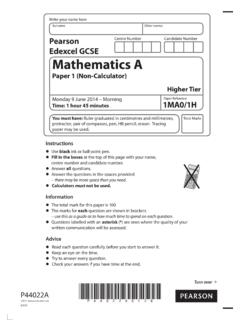Transcription of Pearson Edexcel International GCSE Biology
1 Write your name here Surname Other names Centre Number Candidate Number Pearson Edexcel International gcse . Biology Unit: 4BI0. Paper: 2BR. Monday 16 June 2014 Morning Paper Reference Time: 1 hour 4BI0/2BR. You must have: Total Marks Calculator Instructions t Use black ink or ball-point pen. t Fill in the boxes at the top of this page with your name, centre number and candidate number. t Answer all questions. t Answer the questions in the spaces provided there may be more space than you need. t Show all the steps in any calculations and state the units. t your mind Some questions must be answered with a cross in a box about an answer, put a line through the box . If you change and then mark your new answer with a cross . Information t The total mark for this paper is 60. t use this asfora guide The marks each question are shown in brackets as to how much time to spend on each question.
2 Advice t Read each question carefully before you start to answer it. t Write anyoureyeanswers Keep on the time. t Try to answer everyneatly and in good English. t Check your answersquestion. t if you have time at the end. Turn over P43533A. 2014 Pearson Education Ltd. *P43533A0112*. 1/1/1/. Answer ALL questions. 1 Read the passage below. Use the information in the passage and your own knowledge to answer the questions that follow. Red and Grey Squirrels (Photographer: Matti Parkkonen). Red squirrels live in pine tree habitats in the United Kingdom (UK) where their main predators are birds of prey such as the goshawk. The squirrels mainly eat pine cone seeds. This food is plentiful in the autumn and helps the squirrels increase their body mass. Having a larger body mass helps red squirrels to 5 survive the cold winter conditions.
3 It also means that breeding females are in good condition to produce young in the spring. Red squirrels were common in the UK until a different species, the grey squirrel, was introduced from America in 1876. The two species struggled to exist in the same woodland habitat and it is the red squirrel population that 10 is decreasing. There are estimated to be only 140000 red squirrels left in the UK, and million grey squirrels. The spread of the grey squirrel has been rapid, and in some areas native red squirrels are no longer seen. The grey squirrel outcompetes the red squirrel and there is some evidence that it is also more resistant to disease. The increase in the number of grey 15 squirrels in the UK is having a harmful effect on other native communities where the plants and animals are poorly adapted to withstand their presence.
4 The grey squirrels are causing significant harm to woodland habitats, and recent scientific studies have reported that they are having a serious effect on the number of native woodland birds. 20 The Forestry Commission is an organisation in the UK trying to develop a long-term conservation strategy to save the red squirrel from extinction. It is hoped that this work will help to restore the UK's native biodiversity. 2. *P43533A0212*. (a) Name a secondary consumer in a food chain containing red squirrels. (1).. (b) Suggest how a larger body mass helps squirrels survive the cold winter (lines 4 and 5). (2).. (c) Suggest two reasons why it is an advantage for red squirrels to produce young in the spring (line 6). (2). 1 .. 2 .. (d) (i) What is meant by the term habitat (line 9)? (1).. (ii) What is meant by the term population (line 9)?
5 (1).. (e) Use the data in the passage to calculate the percentage of all the squirrels in the UK that are red. Show your working. (2). percentage .. %. 3. *P43533A0312* Turn over (f ) Give two possible reasons why grey squirrels are increasing in number compared to red squirrels. (2). 1 .. 2 .. (g) Grey squirrels have a greater effect on the number of woodland birds than red squirrels (lines 17 to 19). Suggest how scientists could collect data to support this hypothesis. (3).. (h) Suggest two methods the Forestry Commission might use to save the red squirrel from extinction (line 21). (2). 1 .. 2 .. (Total for Question 1 = 16 marks). 4. *P43533A0412*. 2 (a) The table lists some processes used in plant reproduction. In each box, place a tick (9) if the process helps to produce offspring with genetic variation, or a cross (8) if it produces offspring with no genetic variation.
6 The first one has been done for you. (3). Genetic variation Process in offspring runners producing new plants 8. micropropagation wind-pollination taking cuttings self-pollination of a flower (b) The photograph shows an eight-celled human embryo produced in human reproduction. Describe the events that take place at fertilisation and up to the production of the eight-celled human embryo. (4).. (Total for Question 2 = 7 marks). 5. *P43533A0512* Turn over 3 Flowering plants can respond to their environment through tropic responses. These involve root or shoot tips growing towards or away from a stimulus. A student set up an experiment to investigate how shoots respond to gravity. He placed a potted plant on its side and looked at its growth after 5 days. The diagram shows what he saw. (a) (i) Explain the benefit to the plant of this response.
7 (1).. (ii) Give one variable that the student should keep the same in his experiment and suggest how he could do this. (2).. (iii) Suggest a suitable control for this experiment. (1).. 6. *P43533A0612*. (b) Plants can respond to drought by closing their stomata. (i) Suggest how a plant benefits from closing its stomata when less water is available in the soil. (1).. (ii) Explain the disadvantages to the plant of closing its stomata. (2).. (Total for Question 3 = 7 marks). 7. *P43533A0712* Turn over 4 A student wants to investigate the effect of secretions (juice) from the pancreas on the digestion of protein. The white of an egg is put into fifteen 50 mm long capillary tubes. The tubes are placed in boiling water for 10 minutes until the egg white becomes solid. The diagram shows one of the tubes filled with solid egg white.
8 Capillary tube boiled egg white The fifteen tubes are put into three groups of five. x five tubes are placed in a beaker of distilled water x five tubes are placed into a beaker of juice from the pancreas x five tubes are placed into a beaker of juice from the pancreas that has been boiled After three hours the length of the boiled egg white in each tube is measured in mm. The results are shown in the table. Length of boiled egg white after three hours in mm Juice Boiled juice Distilled water from from the pancreas the pancreas 50 14 50. 50 12 50. 50 13 50. 50 14 50. 50 14 50. (a) (i) Give the dependent variable in this experiment. (1).. 8. *P43533A0812*. (ii) Give two reasons why the results obtained by the student are reliable. (2). 1 .. 2 .. (iii) Suggest how the student can obtain precise measurements of length.
9 (1).. (b) (i) Explain the difference in the results obtained in distilled water compared to juice from the pancreas. (2).. (ii) Explain the difference in the results obtained in pancreas juice compared to boiled juice from the pancreas. (2).. (c) Suggest how you could modify this investigation to find out the effect of pH on protein digestion by pancreas juice. (2).. (Total for Question 4 = 10 marks). 9. *P43533A0912* Turn over 5 Insulin is an important hormone. (a) Name the organ that produces insulin. (1).. (b) State the role of insulin in the body. (2).. (c) (i) Describe how bacteria can be genetically modified to produce human insulin. (5).. (ii) The term that best describes bacteria that have been genetically modified to produce human insulin is (1). A antibiotic B aseptic C pathogenic D transgenic 10.
10 *P43533A01012*. (d) The diagram shows part of a fermenter used to grow large numbers of genetically modified bacteria. motor acid/alkali sterile nutrient medium cold water outlet stirrer pH probe oxygen concentration probe temperature probe cooling jacket cold water inlet air inlet (i) Suggest how the air inlet helps the genetically modified bacteria to grow. (2).. (ii) If the pH probe stops working the pH in the fermenter becomes more acidic. Describe and explain how this affects the production of human insulin. (4).. (Total for Question 5 = 15 marks). 11. *P43533A01112* Turn over 6 Some types of algae are microscopic organisms that can carry out photosynthesis. They produce most of their biomass as fats and oils. If these algae could be grown in large numbers it might help to solve the world's energy crisis because the fats and oils could be turned into biofuel.












